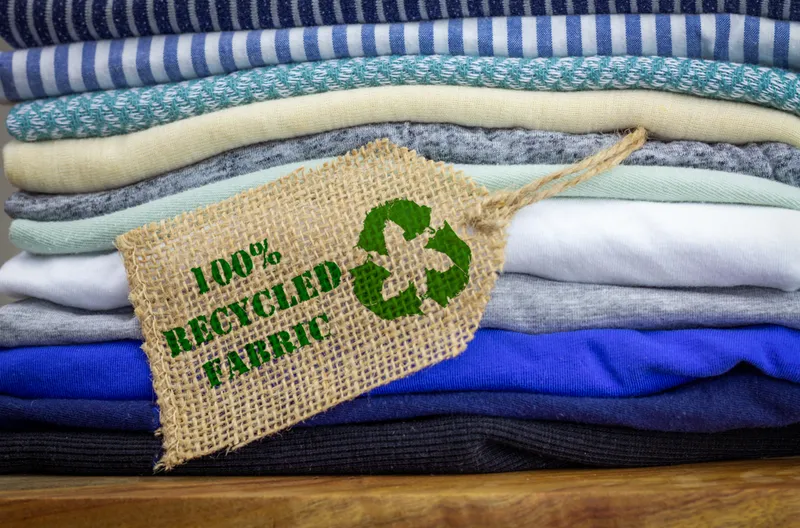Greenwashing or genuine attempts? A deeper look at the sustainability claims of fashion brands
While some fashion brands have responded with genuine efforts at reducing the ecological footprint of their products, countless others claim themselves to be sustainable but are merely greenwashing.
Upon coming across an article of clothing with a tag that says “recycled material,” one is likely to assume that the garment is made of recycled materials.
However, contrary to popular belief, it is highly probable that it is just the tag that is made of recycled material and not the garment itself. This is what a popular fast-fashion brand actually did.

Source: Shutterstock
Covered by Hasan Minhaj on his show The Patriot Act in 2019, he put a spotlight on the diabolical practices of fast fashion brands. While being terrible for the environment, these brands also mislead consumers about their sustainability practices — the instance of ‘recycled’ tag being one such egregious example.
Fashion is one of the most polluting industries in the world. Clothes happen to be one of the most common items people purchase, and the average number of clothes that an individual buys is increasing every year.
With growing social awareness — particularly the role of social responsibility — plays on the brand image, and organisations have recognised that customers are increasingly demanding more sustainable practices. Unfortunately, this has led to an increase in greenwashing.
While some brands have responded with genuine efforts at reducing the ecological footprint of their products, countless others claim themselves to be sustainable but are merely greenwashing.

Source: Shutterstock
As a consumer, the question that naturally arises is how can one differentiate between the two?
First and foremost, it is crucial to remember that there are no silver bullets in sustainability. Becoming an environment-friendly brand is not a one-shot process; it’s a continuous and arduous journey involving multiple milestones that straddle the line between economic viability and social responsibility.
If a brand wants to be sustainable across its entire value chain, it needs to make several changes across different facets of production. From the procurement of raw materials, collection size, and packaging, down to the treatment of product waste.
A complete overhaul is both daunting and impractical. Thus, a smart move on the part of any fashion organisation is to plan the transition.
To start with one critical change, and upon its successful implementation, progress to others. However, the sheer refusal to make these changes in production, while positioning the brand as eco-friendly, is a classic case of greenwashing — an unfortunate common practice in the industry.

Source: Shutterstock
To put it quite simply, if a brand pledges to make one change, for instance — launching a collection made of recycled materials — it would not be considered greenwashing. However, if it markets itself as being completely sustainable, even though 90 percent of its clothes in other collections are not recycled — that’s misleading.
Similarly, if the brand does not make efforts to grow sustainable in other facets over the years, the recycled collection is more likely to just be a marketing gimmick.
Another important area to focus on is the details. Consumers can verify brands’ claims by reading product labels and even writing to the brand to answer any questions. If a garment label claims that an item is made out of 100 percent recycled polyester, they’re walking the talk. However, if it says 10 percent polyester, the picture changes entirely.
Discerning customers can fact-check a brand’s marketing with actual product specifications and practices. If these details aren’t available publicly, they must write to them.

Source: Shutterstock
Genuinely sustainable brands are more likely to be transparent about their methods. If a brand refuses to share information, you’re better off purchasing from somewhere else.
Finally, over and above the tactical steps taken toward sustainability, it’s important to consider a brand’s overall philosophy.
A fast-fashion brand can release any number of sustainable collections, but it wouldn’t change the fact that their entire business model is based on excessive consumerism, mass production, and viewing clothing as disposable.
Look for markers of a sustainable philosophy — small batch collections, minimal (ideally zero) plastic packaging, recycled or biodegradable materials across the entire collection, and transparent supply chains.
When shopping in brands that don’t check these boxes, try sticking staple pieces that are both highly usable and trans-seasonal — they can be worn across seasons and occasions. For example, a pair of pants that can be worn in casual and formal settings. Similarly, a button-down shirt can be worn closed as a top, or open as a second layer.
At the end of the day, the most sustainable way to shop is to consume less and buy only what you need.
Edited by Suman Singh








